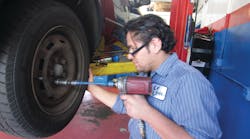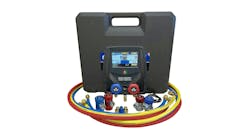Q: Do I really need a torque wrench? Can't you just feel the right torque?
A: Yes, you really need torque wrenches! These days with aluminum oil pans that strip, Ford spark plugs that won't come out and plastic oil filter housings that break from being over tightened, it is absolutely essential to use torque wrenches. Specifications should be referenced on an information system and converted when necessary.
As a quick reference, keep a ft/lbs or ft/in to nM conversion on your tool cart. (See Fig. 1.) Every single oil change with an aluminum oil pan or plastic oil filter housing should require you to pull out your torque wrench. (See Fig. 2.)
There is an old adage that goes "the bigger the better" that technicians have perverted into "the tighter the better." Sometimes, the bigger is not always better and anyone who has broken a stud simply by trying to remove a lugnut knows that tighter is not necessarily better either. Automotive manufacturers spend billions of dollars in research and development. They are not going to publish a dangerously loose axle nut specification or a drain plug torque spec that will result in the vehicle leaking oil everywhere.
Q: Any tips on removing those spark plugs from a Ford 5.4L?
A: If you want to break none of the plugs and have not had luck using the Ford carburetor tune-up cleaner (No. 159220) recommended by the service procedure, use StrongArm "ultra lubricant." If WD-40, PB Blaster, Liquid Wrench or any other brand has worked well for you, then they may be a valid substitute. Let a ton of it soak on the plugs for 15 minutes and carefully tighten and loosen slowly until you ease the plug out with a special 9/16th socket. This works the lubricant into the threads.
If you do it this way, you will not necessarily require the use of the extractor seen in the picture. Be sure to put antiseize not only on the threads, but on the bottom of the spark plug itself so the next set of plugs will go out more easily. (See Fig. 4).
If you broke one of the spark plugs, and let's face it, you probably have, you will have to use a set of extractors. Lisle makes a set (No. 65600) that works well. As you can see in the picture (Fig. 3), the extractors do not need to be used very often if the above tips are employed.
Q: Is it worth biting the bullet and getting a set of impact swivels?
A: Your chrome swivels are not designed to be heated up and used with impact guns (Fig. 5.) The more confidence you have in your tools (and their ability to withstand punishment), the harder and quicker you can work. The spots you have to work with on cars are only getting tighter. The impact swivels will get increasing more handy as time goes on.
Q: What do you think the most underrated hand tool is?
A: Vice grips. You need vice grips in all sizes. What they do is not complicated. Vice grips simply hold something tight that would otherwise just spin in place during removal. On sway bar links when the stud spins when you are removing the nut, rip the boot off and tighten the vice grips as tight as possible there. The nut will come off as you keep the stud stable. On an exhaust manifold where you cannot remove the remaining part of the stud, simply heat it up with acetylene, tighten vice grips on it and spin it out. No other tool can do these every day things.
Q: Can torque sticks replace a torque wrench?
A: No, but not because there is anything inherently wrong with them. A couple of issues might arise when even using torque sticks, so it still pays to do a once over on every lug nut with a torque wrench.
Torque sticks can "go bad" if they get dropped on hard concrete frequently. Though that may not happen at your shop, it is pretty safe to say it happens at most. So it is good protocol to test the torque sticks against a torque wrench. You might get around to this once a year when you service your lifts and your A/C machines. The more common problem with just using torque sticks is that if the air compressor is leaking (or just right below the point in which it starts recompressing), who knows how much torque you are really getting out of that stick.
As a precaution, it is simply good to use both torque sticks and the torque wrench. (See Figs. 6 and 7.) Torque sticks prevent over tightening the lug nut and the torque wrench, as a matter of protocol, proves that there is no fault with your handling of the customer's wheel. It means no comeback and the combination of using both as a matter of procedure results in a much lower chance of there being a problem, even if you forgot to torque the wheel with the torque stick or vice versa. Either way, even in a forgetful moment, you're covered.
Q: What is the benefit of a name-brand ratchet? Some economy ones come with a lifetime guarantee.
A: Let's put the convenience of the warranty aside (what's better than the tool truck guy just handing you a new one the moment you break it?), and talk about the convenience of using a high-end hand tool. Inside a name-brand ratchet are more internal teeth that allow the tool to be used quicker with a smaller ratchet swing, which means you get your job done sooner. Furthermore, they do not break frequently and you can push the tools harder, which allows you to stay on the job longer. Certain economy brands can be very good, however. It is always good to do your research, but generally you get what you pay for.




